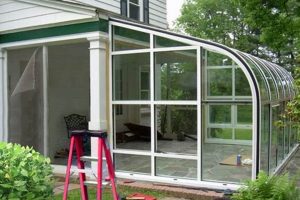A collection of components designed to enable individuals to construct their own illumination devices from scratch can be defined as a do-it-yourself illumination project. These typically include elements such as light sources (LEDs, bulbs), wiring, sockets, switches, enclosures, and instructions. An example would be a package containing all necessary parts to assemble a custom desk lamp or under-cabinet lighting system.
The increasing popularity of constructing lighting solutions stems from a multitude of factors. These factors include cost savings, customization capabilities, educational opportunities, and the satisfaction of creating a functional object. Historically, individuals seeking specialized lighting solutions relied on professional electricians or pre-made products. The advent of affordable electronic components and readily available online resources has empowered a broader audience to undertake such projects. This shift towards self-sufficiency offers enhanced control over the aesthetic and functional aspects of illumination, tailoring it to specific needs and preferences.
The subsequent sections will delve into the various types of available options, the considerations for safe construction practices, and the potential applications for bespoke lighting creations. Examining these facets can illuminate the advantages and disadvantages of pursuing such endeavors.
Essential Construction Guidelines
The following guidelines are crucial for a safe and successful construction endeavor. Careful adherence to these points minimizes potential hazards and ensures a functioning final product.
Tip 1: Verify Component Compatibility: Ensure all components within a do-it-yourself illumination project are electrically compatible. Mismatched voltage or current ratings can lead to component failure or, in severe cases, fire hazards. Consult datasheets for each component to confirm their operational parameters.
Tip 2: Prioritize Safety Grounding: For any project involving mains voltage, proper grounding is paramount. Connect all exposed metal parts to a grounding wire to provide a safe path for fault currents, minimizing the risk of electric shock.
Tip 3: Employ Correct Wiring Techniques: Utilize appropriate wire gauge for the intended current load. Secure all wire connections using suitable connectors or soldering techniques, ensuring robust electrical conductivity and preventing accidental disconnections.
Tip 4: Incorporate Overcurrent Protection: Install fuses or circuit breakers with appropriate current ratings to protect the circuit from overloads or short circuits. This measure prevents damage to components and reduces the risk of fire.
Tip 5: Insulate Exposed Conductors: All exposed electrical conductors must be adequately insulated to prevent accidental contact and short circuits. Use heat shrink tubing or electrical tape to cover exposed wires and connections.
Tip 6: Enclose Electrical Components: Secure all electrical components within an appropriate enclosure. This enclosure provides physical protection, prevents accidental contact with live parts, and can offer environmental protection against dust and moisture.
Tip 7: Test Thoroughly Before Operation: Before powering the completed device, meticulously inspect all wiring and connections. Use a multimeter to verify continuity and absence of short circuits. Gradually increase voltage during initial testing while monitoring for any anomalies.
Adhering to these guidelines provides a foundation for a secure and effective undertaking. Prioritizing safety measures throughout the construction phase minimizes potential risks.
The subsequent section will address potential troubleshooting scenarios and considerations for long-term maintenance.
1. Component Selection
Within the framework of a do-it-yourself illumination package, component selection represents a critical determinant of the project’s ultimate success. The choices made regarding individual parts directly influence the light’s performance characteristics, energy efficiency, safety, and lifespan. A mismatch between components, or the selection of substandard parts, can lead to functional failures, compromised safety, or diminished longevity of the lighting system. For instance, utilizing an LED with insufficient heat dissipation can result in overheating and premature burnout. Similarly, selecting wiring with an inadequate gauge for the intended current can create a fire hazard due to excessive heat generation. The selection process, therefore, is not merely about assembling parts but requires a thorough understanding of electrical principles and component specifications.
The impact of component selection extends beyond basic functionality. The selection of the light source, whether it be an incandescent bulb, fluorescent tube, or LED, determines the color temperature and rendering index, which directly affects the aesthetic qualities of the illuminated space. Furthermore, the quality of the power supply or driver influences the stability of the light output and the energy efficiency of the system. In practical applications, this translates to a choice between a warm, inviting ambiance created by a low color temperature LED versus a bright, functional light achieved with a higher color temperature. Choosing a dimmable LED driver also provides flexibility in controlling the light output.
In conclusion, understanding the crucial role of component selection within a do-it-yourself illumination project is paramount for achieving desired outcomes. The proper selection process leads to functional, efficient, and safe illumination solutions. Incorrect choices, conversely, can result in compromised performance or dangerous situations. Therefore, thorough research and careful consideration of component specifications are necessary for success. The connection highlights the need for a knowledge-driven approach to this undertaking.
2. Wiring Integrity
Within the context of a do-it-yourself illumination package, wiring integrity represents a foundational element directly influencing both safety and operational efficacy. The quality of wiring, encompassing factors such as gauge, insulation, and connection security, serves as a critical determinant of the system’s ability to reliably deliver electrical power to the light source. Compromised wiring integrity, conversely, presents a spectrum of potential hazards ranging from diminished light output and component failure to electrical shock and fire. In essence, the wiring infrastructure constitutes the circulatory system of the illumination device; any impairment to this system inevitably compromises the device’s overall functionality and safety.
The practical significance of wiring integrity manifests in several real-world scenarios. Consider a do-it-yourself project involving the construction of under-cabinet lighting. Insufficient wire
gauge for the current demand can lead to overheating, melting insulation, and potential short circuits. Loose or improperly secured connections can result in intermittent light output, flickering, or complete failure of the lighting system. These issues not only diminish the aesthetic and functional value of the project but also introduce a risk of electrical hazards within the home. Conversely, utilizing appropriately gauged wiring, implementing secure connections, and ensuring adequate insulation contributes to a stable, reliable, and safe illumination system. Proper wiring also ensures the longevity of the light source by preventing voltage drops and current fluctuations that can damage sensitive electronic components such as LEDs.
In conclusion, wiring integrity constitutes an indispensable aspect of any successful do-it-yourself illumination project. Addressing this facet demands a comprehensive understanding of electrical principles, meticulous execution, and a commitment to utilizing high-quality materials. Overlooking wiring integrity not only jeopardizes the functionality and lifespan of the project but also introduces significant safety risks. Therefore, attention to detail regarding wiring practices is paramount for anyone undertaking the creation of custom illumination systems. The challenges associated with electrical work underscore the need for thorough research, adherence to safety protocols, and, when necessary, consultation with qualified professionals.
3. Circuit Protection
Circuit protection mechanisms are integral to the safe and reliable operation of any do-it-yourself illumination package. These mechanisms, including fuses and circuit breakers, safeguard the electrical circuit from overcurrent conditions, which can arise from short circuits, component failures, or excessive load demands. Without adequate circuit protection, such overcurrents can lead to overheating, insulation breakdown, fire hazards, and damage to the components within the illumination system. Consider a scenario where a short circuit develops within a custom-built LED desk lamp. Without a properly rated fuse, the resulting high current could rapidly overheat the wiring, potentially igniting surrounding materials. The fuse, designed to interrupt the circuit at a predetermined current level, prevents this hazardous situation.
The selection of appropriate circuit protection devices necessitates an understanding of the circuit’s operating voltage, current requirements, and the characteristics of the load. Fuses are typically rated by their current carrying capacity and their breaking capacity, which represents the maximum current they can safely interrupt. Circuit breakers, while more expensive, offer the advantage of being resettable after a fault condition is cleared. In practice, incorporating a fuse or circuit breaker rated slightly above the normal operating current of the illumination system provides a safety margin while ensuring prompt protection against overcurrents. The placement of the protection device is also critical; it should be located as close as possible to the power source to protect the entire circuit.
In conclusion, circuit protection is not merely an optional addition but a mandatory safety feature for any do-it-yourself illumination package. Its absence significantly increases the risk of electrical hazards and component damage. By incorporating properly rated fuses or circuit breakers and adhering to sound electrical practices, individuals can ensure the safe and reliable operation of their custom-built lighting systems. The understanding of the need for circuit protection and its appropriate implementation is paramount in promoting safety when constructing electrical devices.
4. Enclosure Safety
Enclosure safety is paramount in any do-it-yourself illumination project, serving as a critical line of defense against potential electrical hazards and physical damage. The enclosure’s primary function is to isolate electrical components, such as wiring, connections, and power supplies, from the surrounding environment, preventing accidental contact with live parts and mitigating the risk of electric shock. Furthermore, the enclosure provides physical protection against dust, moisture, and impact, safeguarding the internal components from damage and ensuring the longevity of the lighting system. The choice of enclosure material, design, and construction directly impacts the overall safety and reliability of the completed device. For instance, a poorly constructed enclosure with inadequate insulation or ventilation can create a fire hazard or lead to premature component failure.
Real-world examples underscore the importance of enclosure safety. Consider a do-it-yourself project involving the creation of outdoor garden lighting. An enclosure lacking proper weatherproofing can allow moisture to ingress, leading to corrosion, short circuits, and potential ground faults. Similarly, an enclosure constructed from flammable material poses a significant fire risk if internal components overheat. Conversely, selecting an enclosure made from durable, non-conductive materials with appropriate ingress protection (IP) ratings provides a safe and reliable housing for the electrical components, ensuring long-term performance and minimizing the risk of electrical hazards. In practical applications, this translates to selecting a weatherproof enclosure with a secure lid and sealed cable entry points for outdoor lighting or a fire-resistant enclosure with adequate ventilation for indoor applications involving high-power LEDs.
In conclusion, enclosure safety constitutes an indispensable aspect of do-it-yourself illumination projects. Selecting an appropriate enclosure that provides adequate insulation, physical protection, and environmental sealing is crucial for ensuring the safety and reliability of the completed lighting system. The challenges associated with proper enclosure selection highlight the need for careful consideration of the project’s specific requirements and the potential hazards involved. Adhering to established safety standards and best practices related to electrical enclosures is essential for anyone undertaking the creation of custom illumination systems.
5. Testing Protocol
A rigorous testing protocol is an indispensable component of any do-it-yourself illumination project. The implementation of thorough testing procedures serves as the primary means of verifying the correct assembly and safe functionality of the constructed lighting system. Without a structured testing regime, potential electrical faults, wiring errors, and component malfunctions may remain undetected, posing significant risks of electrical shock, fire, and equipment damage. The connection between testing and safe operation is therefore direct and causal. For example, a continuity test, performed using a multimeter, can confirm the absence of short circuits before power is applied. Similarly, a voltage test verifies that components are receiving the intended voltage levels. Failure to perform these tests could result in catastrophic component failure or, more seriously, a safety hazard.
The practical significance of testing extends beyond basic functionality. Performance testing can assess the light output, color temperature, and energy effici
ency of the system, ensuring that it meets the intended design specifications. A lux meter, for instance, can quantify the illuminance provided by the light, while a power meter can measure its energy consumption. This data informs design adjustments and allows for optimization of the lighting system’s performance. A load test, where the system is operated continuously for an extended period, reveals potential thermal issues or component weaknesses. This proactive approach to testing allows builders to identify and rectify any problems before the lighting system is put into service, preventing failures and extending its lifespan.
In conclusion, the establishment and adherence to a comprehensive testing protocol is not merely a recommended practice but an essential requirement for any do-it-yourself illumination endeavor. It forms the critical link between construction and safe, reliable operation. The absence of adequate testing invites unforeseen risks and compromises the overall quality and longevity of the lighting system. Implementing appropriate testing procedures, while demanding, significantly reduces the likelihood of electrical hazards and ensures that the completed project aligns with its intended design parameters. The importance of this facet cannot be overstated.
Frequently Asked Questions Regarding DIY Light Kit Construction
The following section addresses frequently encountered questions and concerns regarding the assembly and utilization of do-it-yourself illumination packages. The information presented aims to provide clarity and promote safe construction practices.
Question 1: What level of electrical knowledge is required to safely construct a DIY light kit?
A foundational understanding of basic electrical principles, including voltage, current, resistance, and Ohm’s Law, is essential. Familiarity with wiring techniques, circuit diagrams, and safety practices is also necessary. Individuals lacking this knowledge are strongly advised to seek guidance from a qualified electrician.
Question 2: Can a DIY light kit be used to replace existing hardwired lighting fixtures?
Direct replacement of hardwired fixtures with a constructed illumination device is not generally recommended without proper electrical expertise and adherence to local building codes. Modifying existing electrical installations can pose significant safety hazards if not performed correctly.
Question 3: What are the potential risks associated with constructing a DIY light kit?
Potential risks include electrical shock, fire, component failure, and exposure to hazardous materials. These risks can be mitigated by following safety guidelines, using appropriate tools and materials, and exercising caution throughout the construction process.
Question 4: Where can one obtain reliable information and guidance for building a DIY light kit?
Reputable sources of information include electrical engineering textbooks, online tutorials from established electronics suppliers, and consultations with qualified electricians. It is crucial to verify the accuracy and reliability of any information obtained from online sources.
Question 5: What type of tools are necessary for assembling a DIY light kit?
Essential tools typically include wire strippers, wire cutters, a multimeter, soldering iron (if soldering is required), screwdrivers, and safety glasses. The specific tools required may vary depending on the complexity of the project.
Question 6: How can one ensure the longevity and reliability of a constructed DIY light kit?
Ensuring longevity requires utilizing high-quality components, following proper wiring techniques, providing adequate circuit protection, and implementing a suitable enclosure. Regular inspection and maintenance can also help prolong the lifespan of the system.
The prudent construction and utilization of a do-it-yourself illumination package require careful planning, execution, and adherence to safety protocols. It should be done with expertise or guidance.
The following section will present future outlook on this topic.
Conclusion
The preceding analysis has explored the various facets of “diy light kit” construction, ranging from component selection and wiring integrity to circuit protection, enclosure safety, and rigorous testing protocols. These elements collectively determine the safety, reliability, and functionality of custom-built illumination systems. The absence of attention to any of these areas introduces significant risks, potentially compromising the performance of the device or, more seriously, creating hazardous conditions. The responsible construction of such systems, therefore, demands a thorough understanding of electrical principles and a commitment to adhering to established safety guidelines.
As technology continues to evolve and the availability of affordable electronic components expands, the accessibility of constructing bespoke illumination solutions will likely increase. However, this increased accessibility necessitates a concurrent emphasis on education and awareness regarding the potential risks involved. A future where “diy light kit” construction is both safe and prevalent relies on the dissemination of accurate information, the promotion of responsible building practices, and the availability of resources to support individuals in their endeavors. Pursuing such activities demands expertise or a qualified professional.







